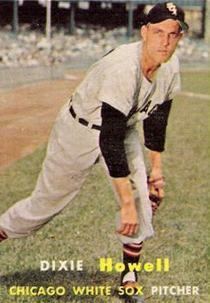Win–loss record 19–15 Role Baseball player Name Dixie Howell | Innings pitched 226⅓ Earned run average 3.78 | |
 | ||
Died March 18, 1960, Hollywood, Florida, United States | ||
Millard Filmore "Dixie" Howell (January 7, 1920 – March 18, 1960) was a relief pitcher who played in six Major League Baseball seasons between 1940 and 1958 as well 19 years in the minors. Listed at 6 ft 2 in (1.88 m), 210 lb., Howell batted left-handed and threw right-handed. A native of Bowman (or Harold), Kentucky, he grew up in Dehue, West Virginia.
Contents
Career
Howell spent three years in the Cleveland Indians minor league system (1937–39) before joining the big team in 1940. While in the minors, he set a record in the Eastern League by striking out 20 batters in a single game (1939). In three relief appearances for the Indians, he posted a 1.80 ERA in five innings pitched and did not have a decision. Despite being regarded as one of the finest prospects in the Cleveland organization, recurring illness and sore arm problems kept him from reaching his full potential.
In 1943, Howell was purchased by the Cincinnati Reds and assigned to the International League. He helped the Syracuse Chiefs clinch the league pennant with a 13–9 mark and was promoted to the major league roster for the next season. But in November 1943, he entered military service with the U.S. Army. He served in France and Belgium during World War II and was taken prisoner by the German troops in September 1944, being liberated by advancing Allied forces six months later. He returned to the United States and was discharged from military service late in 1945.
Howell went to spring training with Cincinnati in 1946, playing for Syracuse for the next four years. He had a 17–12 record with the Chiefs in 1948, and appeared in five games with the Reds in 1949.
In 1950, Howell was purchased by the New York Giants and assigned to the Minneapolis Millers of the American Association. He enjoyed a fine season with the Millers, going 14–2 during the regular season and pitching a no-hitter against Columbus on August 10. Recurring arm problems made him consider retiring before returning to Minneapolis in 1952, but he decided to stay playing. Nevertheless, he was sold to Philadelphia Phillies on January 20, returned to the Giants on May 15, purchased by the Chicago White Sox a week later, and assigned to the Memphis Chicks of the Southern Association, where his timely relief pitching led Memphis to the Dixie Series title.
Howell remained with the Chicks in 1953 and 1954, before returning to major league action in 1955 with the White Sox, now as an experimented relief specialist, and for the next four years. His most productive season came in 1955, when he recorded career-highs in wins (8), ERA (2.93), saves (9), games finished (25) and innings (73⅔ ).
In a six-season career, Howell posted a 19–15 record with a 3.78 ERA and 19 saves in 115 appearances, including 99 strikeouts, 103 walks, two starts, 68 games finished and 226⅓ innings of work. He also helped himself with the bat, hitting a .243 average (18-for-74) with five home runs and nine RBI in 124 games, including two doubles, one triple, eight runs, and a solid .500 slugging percentage.
After that, Howell pitched for the Indianapolis Indians of the American Association in 1958 and 1959. Unfortunately, he died at age 40 after suffering a heart attack while running at the Indians' 1960 spring training camp in Hollywood, Florida.
